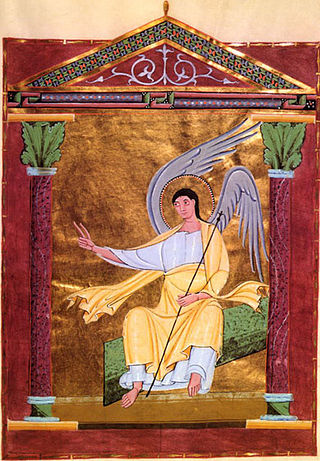
The Pericopes of Henry II is a luxurious medieval illuminated manuscript made for Henry II, the last Ottonian Holy Roman Emperor, made c. 1002–1012 AD. The manuscript, which is lavishly illuminated, is a product of the Liuthar circle of illuminators, who were working in the Benedictine Abbey of Reichenau, which housed a scriptorium and artists' workshop that has a claim to having been the largest and artistically most influential in Europe during the late 10th and early 11th centuries. An unrivalled series of liturgical manuscripts was produced at Reichenau under the highest patronage of Ottonian society.
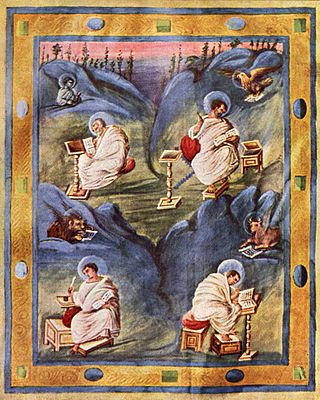
Carolingian art comes from the Frankish Empire in the period of roughly 120 years from about 780 to 900—during the reign of Charlemagne and his immediate heirs—popularly known as the Carolingian Renaissance. The art was produced by and for the court circle and a group of important monasteries under Imperial patronage; survivals from outside this charmed circle show a considerable drop in quality of workmanship and sophistication of design. The art was produced in several centres in what are now France, Germany, Austria, northern Italy and the Low Countries, and received considerable influence, via continental mission centres, from the Insular art of the British Isles, as well as a number of Byzantine artists who appear to have been resident in Carolingian centres.

Ottonian art is a style in pre-romanesque German art, covering also some works from the Low Countries, northern Italy and eastern France. It was named by the art historian Hubert Janitschek after the Ottonian dynasty which ruled Germany and Northern Italy between 919 and 1024 under the kings Henry I, Otto I, Otto II, Otto III and Henry II. With Ottonian architecture, it is a key component of the Ottonian Renaissance. However, the style neither began nor ended to neatly coincide with the rule of the dynasty. It emerged some decades into their rule and persisted past the Ottonian emperors into the reigns of the early Salian dynasty, which lacks an artistic "style label" of its own. In the traditional scheme of art history, Ottonian art follows Carolingian art and precedes Romanesque art, though the transitions at both ends of the period are gradual rather than sudden. Like the former and unlike the latter, it was very largely a style restricted to a few of the small cities of the period, and important monasteries, as well as the court circles of the emperor and his leading vassals.

Situla, from the Latin word for bucket or pail, is the term in archaeology and art history for a variety of elaborate bucket-shaped vessels from the Bronze Age to the Middle Ages, usually with a handle at the top. All types may be highly decorated, most characteristically with reliefs in bands or friezes running round the vessel.

The Bavarian National Museum in Munich is one of the most important museums of decorative arts in Europe and one of the largest art museums in Germany. Since the beginning the collection has been divided into two main groups: the art historical collection and the folklore collection.

Johann Michael Ferdinand Heinrich Hofmann was a German painter of the late 19th to early 20th century. He was the uncle of the German painter Ludwig von Hofmann. He was born in Darmstadt and died in Dresden. He is best known for his many paintings depicting the life of Jesus Christ.

The Harbaville Triptych is a Byzantine ivory triptych of the middle of the 10th century with a Deesis and other saints, now in the Louvre. Traces of colouring can still be seen on some figures. It is regarded as the finest, and best-preserved, of the "Romanos group" of ivories from a workshop in Constantinople, probably closely connected with the Imperial Court.

Egbert was the Archbishop of Trier from 977 until his death.

The Gospels of Otto III is considered a superb example of Ottonian art because of the scope, planning, and execution of the work. The book has 276 parchment pages and has twelve canon tables, a double page portrait of Otto III, portraits of the four evangelists, and 29 full page miniatures illustrating scenes from the New Testament. The cover is the original, with a tenth-century carved Byzantine ivory inlay representing the Dormition of the Virgin. Produced at the monastery at Reichenau Abbey in about 1000 CE, the manuscript is an example of the highest quality work that was produced over 150 years at the monastery.
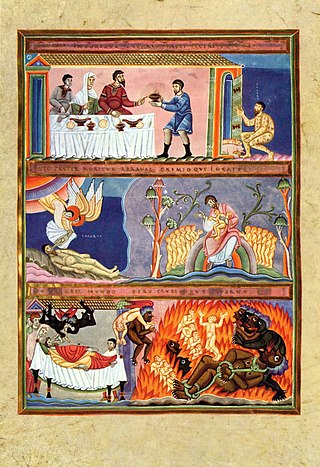
The Codex Aureus of Echternach is an illuminated Gospel Book, created in the approximate period 1030–1050, with a re-used front cover from around the 980s. It is now in the Germanisches Nationalmuseum in Nuremberg.
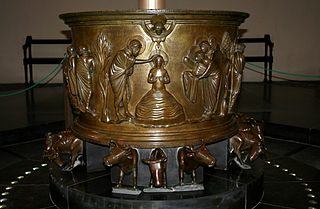
The baptismal font at St Bartholomew's Church, Liège is a Romanesque brass or bronze baptismal font made between 1107 and 1118 now in St Bartholomew's Church, Liège in Liège, Belgium. The font is a major masterpiece of Mosan art, remarkable for the classicism of its style, whose origin has been the subject of great debate among art historians. The Meuse river valley in modern Belgium and France, roughly coterminous with the Diocese of Liège, was the leading 12th-century centre of Romanesque metalwork, which was still the most prestigious medium in art.
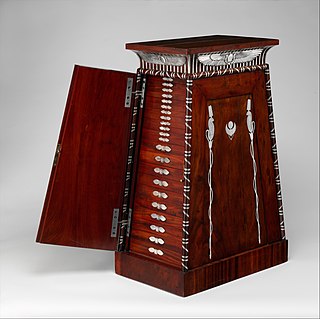
Egyptian revival decorative arts is a style in Western art, mainly of the early nineteenth century, in which Egyptian motifs were applied to a wide variety of decorative arts objects.

The Cross of Lothair or Lothair Cross is a crux gemmata processional cross dating from about 1000 AD, though its base dates from the 14th century. It was made in Germany, probably at Cologne. It is an outstanding example of medieval goldsmith's work, and "an important monument of imperial ideology", forming part of the Aachen Cathedral Treasury, which includes several other masterpieces of sacral Ottonian art. The measurements of the original portion are 50 cm height, 38.5 cm width, 2.3 cm depth.

Hessisches Landesmuseum Darmstadt (HLMD) is a large multidisciplinary museum in Darmstadt, Germany. The museum exhibits Rembrandt, Beuys, a primeval horse and a mastodon under the slogan "The whole world under one roof". As one of the oldest public museums in Germany, it has c. 80,000 visitors every year and a collection size of 1.35 million objects. Since 2019, Martin Faass has been director of the museum. It is one of the three Hessian State museums, in addition to the museums in Kassel and Wiesbaden. Similar institutions in Europe are the Universalmuseum Joanneum in Graz and the National Museum of Scotland in Edinburgh.

The Codex Wittekindeus is a 128-folio illuminated Gospel Book, produced in Fulda Abbey in Germany around 970–980. Alongside the Gero Codex, the Codex Wittekindeus is considered one of the two "greatest works in the initial Ottonian revival of book-illumination".
The Salerno Ivories are a collection of Biblical ivory plaques from around the 11th or 12th century that contain elements of Early Christian, Byzantine, and Islamic art as well as influences from Western Romanesque and Anglo-Saxon art. Disputed in number, it is said there are between 38 and 70 plaques that comprise the collection. It is the largest unified set of ivory carvings preserved from the pre-Gothic Middle Ages, and depicts narrative scenes from both the Old and New Testaments. Some researchers believe the Ivories hold political significance and serve as commentary on the Investiture Controversy through their iconographies. The majority of the plaques are housed in the Diocesan Museum of the Cathedral of Salerno, which is where the group's main namesake comes from. It is supposed the ivories originated in either Salerno and Amalfi, which both contain identified ivory workshops, however neither has been definitively linked to the plaques so the city of origin remains unknown. Smaller groups of the plaques and fragments of panels are currently housed in different museum collections in Europe and America, including the Metropolitan Museum of Art in New York, the Louvre in Paris, the Museum of Fine Arts in Budapest, the Hamburg Museum of Art and Trade, and the Sculpture Collection in the Berlin State Museums.

The Spitzer Cross c. 1190, is a gilded champlevé enameled Crucifix, made in Limoges, France, by an unknown artisan whom scholars have named the "Master of the Royal Plantagenet Workshop" and "Master of the Grandmont Altar." This meticulously crafted piece is considered one of the finest surviving examples of Limoges enamel from the Medieval period. Once part of the famous Spitzer Collection for whom it is named, it is now in the permanent collection of the Cleveland Museum of Art.
The Treasure of the Basel Minster was the church treasure of the Basel Minster in Switzerland, gathered there over a period of more than 500 years. During the Middle Ages, Basel was the seat of the Diocese of Basel, and its Minster contained an extraordinarily rich treasure. During the Partition of the canton of Basel in 1833, the treasury was split between Basel-City and Basel-Country, and the part falling to Basel-Country was split up and sold.

Albert of Brandenburg as Saint Jerome is a 1527 oil on panel painting by Lucas Cranach the Elder, who was a Protestant but also worked for Catholic patrons. It shows Albert of Brandenburg. It and the Solly Madonna were bought by the Kingdom of Prussia in 1821 as part of Edward Solly's collection and are both now in the Gemäldegalerie in Berlin.






















